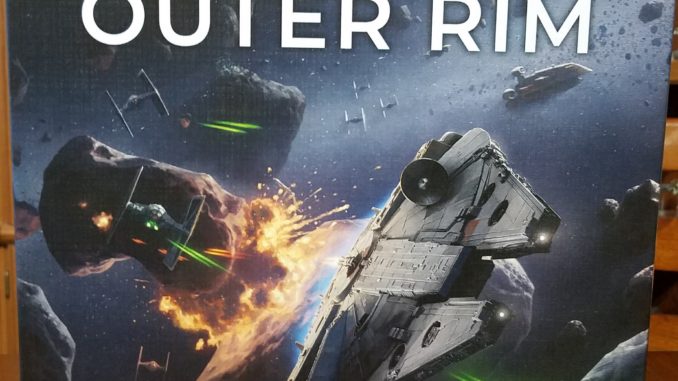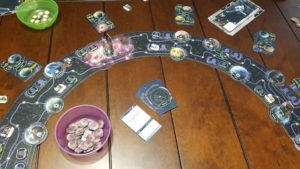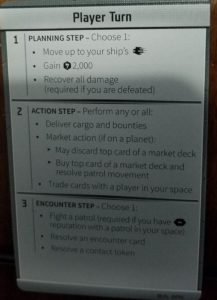
Back in July, Barnes and Noble had a special summer sale running at the same time as a strategy game sale. The combination of sales allowed for some things at 50% off. I was ready to grab myself a copy of Star Wars: Outer Rim at that excellent price but by the time I went to check out it had been pulled from the sale. This was quite frustrating. Fortunately, I did end up getting it for my birthday a month later. Since then, I’ve had ample opportunity to play it.
Production- B+
 While most of the game’s pieces are cardboard it is a sturdy type of cardboard. Nothing feels like it will bend easily. The ship cards are the flimsiest piece but those are more cardstock than cardboard. They don’t need to be thick. The decks of cards are similar, sturdy enough but will fray with time and ample shuffling.
While most of the game’s pieces are cardboard it is a sturdy type of cardboard. Nothing feels like it will bend easily. The ship cards are the flimsiest piece but those are more cardstock than cardboard. They don’t need to be thick. The decks of cards are similar, sturdy enough but will fray with time and ample shuffling.
The game’s artwork is a typical FFG affair. In fact, if you play any of their other Star Wars games (RPG, X-Wing, Armada, Destiny, Legion, Imperial Assault) you’ll recognize most of the images. That’s not necessarily a knock against it. The artwork is very well done. But the more often you see the same artwork, the more it appears FFG is being cheap. Especially since, and I say this with no actual knowledge, I expect the artists got paid one flat, low, fee and their work is being used across multiple games.
Theme- B+
The game lays all the groundwork for a Star Wars experience. The ships, the gear, the characters are all Star Wars staples. You take on the role of one of these characters as you try to make your way in the universe. There are several routes you can take to victory; Bounty Hunter, Smuggler, innocent trader, Imperial/Rebel Agent. Out of those, the game does the best job making you feel like a Bounty Hunter. You have targets and must go searching the Outer Rim for them. Then you have to fight them and decide if they live or die. You can even get bounties for the other players crew. Or even your own.
In one game, I was Evil Han Solo. I captured Hera Syndulla so the Rebels hated me and the Empire loved me. And then I took a bounty on Chewbacca. Who was a member of my crew. I killed Chewie in order to win the game. Felt like true scum there.
The other roles are a little harder to get into. There are only a few missions that really have you working for the Rebels or Empire. And smuggling has a mechanic where you might get caught while delivering your illegal cargo. But mostly due to the way the Patrols work (ships from the Empire, Rebellion, Hutts and Syndicate) you rarely have to worry about avoiding them.
Much of the game’s Star Wars feel does come down to how much of a Star Wars nerd you already are. Since, if you’re buying this game, you probably are already a Star Wars nerd you’ll probably do just fine.
Gameplay- B
 The main goal of the game is to become the most famous piece of scum in the galaxy. You do this by being the first to gain the required amount of Fame (8 for the tutorial, 10 for most games, but you can elect to require 12 for more advanced games). You gain fame a variety of ways, most of which comes from completing Bounties, Jobs or Delivering special cargo. Each character starts with a Job/Bounty appropriate to them and has a unique character Goal to achieve. For example, Boba Fett has a personal goal to complete two bounties and starts the game with one random bounty in progress. Han Solo has a personal goal of having an expensive ship and starts with a job delivering cargo.
The main goal of the game is to become the most famous piece of scum in the galaxy. You do this by being the first to gain the required amount of Fame (8 for the tutorial, 10 for most games, but you can elect to require 12 for more advanced games). You gain fame a variety of ways, most of which comes from completing Bounties, Jobs or Delivering special cargo. Each character starts with a Job/Bounty appropriate to them and has a unique character Goal to achieve. For example, Boba Fett has a personal goal to complete two bounties and starts the game with one random bounty in progress. Han Solo has a personal goal of having an expensive ship and starts with a job delivering cargo.
Each player takes a Turn consisting of three steps. The first, called Planning, is the simplest but the most powerful. You have the choice between moving, gaining money or recovering all of your damage. You usually want to be able to do all three. If you’re on the wrong planet, hurt, and running low on funds it can be a tough choice what to do. From experience, gaining money is the choice you want to pick last. If you’re on the planet you need to be on and undamaged, take the money. Otherwise, you probably need to be moving.
Step two, the Action step, conversely allows you to do everything. This is where you deliver goods to complete missions, buy something from the Market, trade with other players, or do special character or card actions. It feels freeing but, naturally, none of these actions are as powerful. You need to deliver things to win but you’re not going to be doing that every round.
 The Market action is the main one from this stage. The Market is where you get your gear and most of your missions.There are several decks you can choose to buy from if you are on a planet. Each deck has a main theme (Gear, Ships, Bounties, Jobs, Cargo, Shipyard) but each can also have any type of card (except the shipyard, that’s just ships). When you go to the Market you can buy one thing but can also flip one card and put it on the bottom of its deck first. This allows you to fish for a card you might want or to flip down a card you don’t want an opponent to get (such as a Bounty showing for one of your crew).
The Market action is the main one from this stage. The Market is where you get your gear and most of your missions.There are several decks you can choose to buy from if you are on a planet. Each deck has a main theme (Gear, Ships, Bounties, Jobs, Cargo, Shipyard) but each can also have any type of card (except the shipyard, that’s just ships). When you go to the Market you can buy one thing but can also flip one card and put it on the bottom of its deck first. This allows you to fish for a card you might want or to flip down a card you don’t want an opponent to get (such as a Bounty showing for one of your crew).
Gear, ships and crew are important components to gather as they help you complete missions to gain Fame. Many of them, mostly crew, offer Keywords which come into play when doing certain Jobs. You’ll often have to do skill checks. If you don’t have the skill, you have a 1/8 chance on two d8’s to succeed. If you have the Keyword, you have 50% chance on each dice. If you have two copies of the Keyword, your odds go up to 75% per die. Keywords are quite handy.
Finally, in the last phase of your turn you must perform some form of Encounter. There are two main options for Encounters. The first, is to encounter the space you’re in. If you’re at a planet you draw from a special deck which has encounters for the two planets on your tile. These are themed for your planet. They might be things that happen immediately, such as a fight, or getting an opportunity to work for the faction on the planet. They might also be Secret cards, which you keep and can be used later for a special bonus.
Alternatively, you can Encounter someone in your space. This is usually one of the characters on the planet. These are all dealt out randomly at the beginning of the game face down. Each character has a color which gives you a clue to who they might be. More powerful, and iconic, characters are yellow and more generic low-level characters are white with green being in the middle. You might have a Bounty for Hera Syndulla, as my Evil Han Solo did. You’ll know she’s yellow so you’ll want to Encounter all the yellow characters until you find her. When you Encounter a character, you can either fight them if you have a Bounty or draw their unique card from the Encounter deck. Each card is different and often gives you the chance to recruit them as part of your crew. Some give out missions instead.
Rather than encountering a character, you can also encounter a ship that is in your spot. There are four Patrol ships, one for each faction, that move around the galaxy. Anytime someone buys something from the market, one of these ships will move. If they like you, it’s no big deal. If they are neutral to you, they’ll halt your movement in their space. But if they are hostile, then you are forced to Encounter them in a fight. You can also choose to fight them if they aren’t hostile. Defeating a Patrol ship does come with rewards. The first tier of ship gives money but the second two tiers award valuable Fame. However, these are risky as the final tier of ship is unbeatable and if you Encounter it, you just lose (note you can not die in this game, merely lose money and must spend a valuable Planning step healing).
Expansions- TBD
The game has a strong feel that it was designed around planned expansions. It would be very easy to add new sectors to the game board. And the Encounter deck of cards skips a lot of numbers. Why jump from the fifties to the nineties if you didn’t plan to add more cards to the deck?
Conclusion- B+
Overall, I want to like the game more than I actually do. It feels very similar to the Firefly game, not without reason as it is a very similar theme. I like it better than the Firefly game as it fixes some of those issues. It goes faster, is not as dependent on keywords and there are more ways to interact and interfere with the other players.
First, Keywords help your chances at success but they don’t guarantee it. That is Firefly’s biggest weakness. Get all the right Keywords and Misbehaving was guaranteed to succeed. Second, interacting with other players is almost non-existent in Firefly. There’s not much of it in Outer Rim but there are some Bounties you can get for other players and you can go after their crew. Playing the Market game is also more important as you can flip down cards to keep them from other players. This can be decisive near the endgame.
Despite the improvements, and my love of Star Wars, it’s not a very complicated game. Personally, I enjoy games more when you have to play them a few times to learn how everything fits together. There’s no puzzle here, just a race. Which is fine. The rest of my family really enjoys it and I don’t dislike it. I just wanted to like it more.
Wayne Basta
Latest posts by Wayne Basta (see all)
- X-Wing Tier List – Rebels - May 10, 2023
